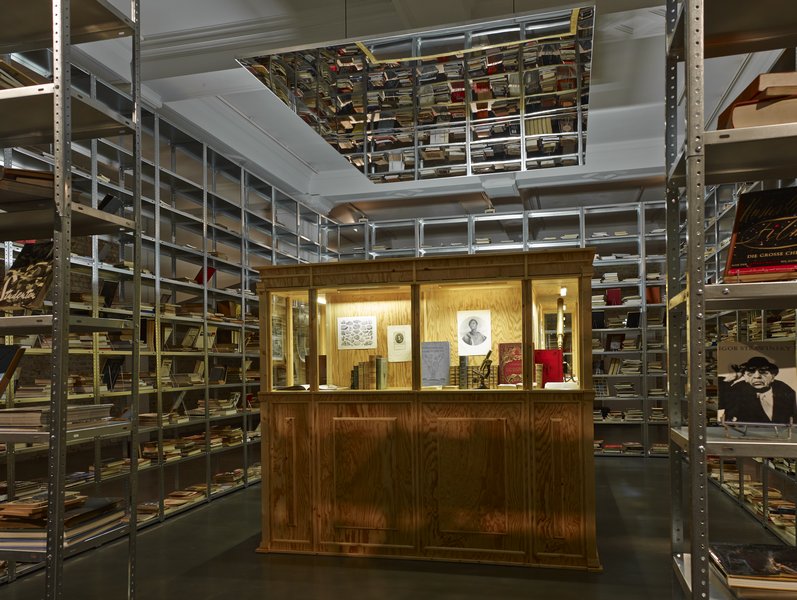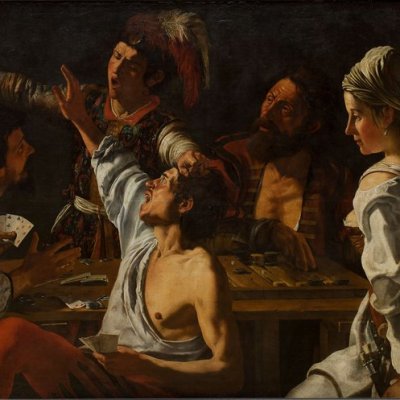From the April issue of Apollo: preview and subscribe here
Kader Attia takes historical images and artefacts and rearranges them in unexpected ways. On the eve of a major retrospective of his work in Lausanne, he talks to Apollo about why he feels the need to refashion the past
‘This object I find fascinating, even magical.’ Kader Attia has placed an ancient African injury mask on his desk. It is made from dark iron, with cut out eyes, and a nose whose crude shape suggests deformation. Still, the mask is grinning. ‘In 2,000 years’ time, the room we’re in will not exist, it will be virtual,’ the artist continues, fervently. ‘But this mask before us now is strong.’
Like the mask, the particular history of which we will return to, Attia’s art speaks of forgotten histories and wounded pasts, of layers of subjective identity. ‘The mask was part of a society that feels isolated from us now, but that has its own iconographic culture, its own psyche,’ he continues. ‘When I say “magical”, I’m not speaking about magic in a naive way, but maybe I want to say: there is something irrational about art; that is why I am attracted to it.’ He puts the mask aside. ‘Mathematics can explain almost everything; there are equations for gas and the way that smoke blows, but it cannot explain art.’
Attia’s work is not characterised by a particular aesthetic or format, but evolves according to what he describes as ‘the unexpected possibility of discovery’. The French-Algerian artist (b. 1970) is invested in the materiality of objects, as much as in the intangible nature of knowledge. Objects uncovered in his research in museum archives, become the starting point for vast works, often combining centuries-old found items with originally cast sculptures. The object that inspired his room-sized installation, The Repair from Occident to Extra-Occidental Cultures at dOCUMENTA(13) in 2012, for example, was a piece of cloth made by the Kuba people of the Congo, the holes of which had been patched up with Vichy fabric: a basic act of repair that made a powerful point about cultural appropriation.
This relationship between objects, places and ideas, will soon be played out in a retrospective at the Musée cantonal des Beaux-Arts in Lausanne, Switzerland, which will bring together works from Attia’s diverse output, from photography and film, to sculpture and installation. The idea of repair is woven through many of these pieces – that fixed-up piece of fabric now informs both the philosophy and the process of his art. ‘It’s my first retrospective, in the sense of reuniting and re-enacting old pieces,’ he says of his site-specific adaptations, ‘making them relevant to the time we’re living in today.’
We’re in the artist’s studio – a cluttered room across a courtyard on the edge of Berlin’s Prenzlauer Berg – but the archives of ethnographic museums are, Attia says, just as much a part of his workspace. ‘Berlin is like living in a huge studio – there are so many museums here related to history, I just go back and forth between them.’ He moved to the city from his native Paris seven years ago, in order to have more space and time, after ruling out Algiers as too impractical: ‘If you do installation or sculpture, it’s very hard to create in Algiers – it’s a nightmare to get works out of there.’
Rochers-Carres1 From the ‘Rochers Carrés’ photographs (2008), Kader Attia. Courtesy the artist; Barjeel Art Foundation ;Sharjah Art Foundation; Sociéte Générale; private collection; and Galerie Nagel Draxler © Kader Attia

Like most international artists, he has travelled – still travels – widely: his first solo exhibition of photography took place in 1996 in the Congo, where he was doing his obligatory non-military service; his subsequent photography series represents architectural sites in Algeria. On the cubic boulders featured in Rochers Carrés (2008), young men look out over the Mediterranean; the image is like a détournement of Caspar David Friedrich’s wanderer, transposed to North Africa.
The transition from photographs to sculpture and installation came via the medium of collage, where he cuts, edits, or ‘repairs’ old images into new formations. Across media, Attia’s works take residence in the space of his own cultural identity. A back and forth from Occident to ‘Orient’, along with an insistent questioning of these categories, provides the momentum for his creations.
Berlin has become best known as a city that offers space and time, or creative freedom; the office of Attia’s studio, however, is, as he would say, rempli – completely full. The desk is covered in archive boxes, film negatives, books on colonialism, and Riad Sattouf’s graphic novel L’Arabe du Futur (‘The Arab of the Future’; 2014). It’s like a working Tower of Babel. For if Attia claims he is attracted to art’s inexplicable qualities, he is also clearly curious about explanations of humanity that cross disciplines and cultures. Before a year at Barcelona’s School of Applied Art ‘La Massana’, he studied philosophy and fine art in Paris in 1993, which comes across in his conversation (during the course of which he mentions Descartes, Darwin, Nietzsche, and Foucault, to name a few), and in the erudite allusions in his work.
Continuum of Repair: The Light of Jacob’s Ladder (2013), Installation view at the Whitechapel Gallery, London, 2013. Courtesy the artist, Irene Panagopoulos Collection, Galerie Krinzinger, Galerie Nagel Draxler, and Galleria Continua. Photo: Simon White © Kader Attia

Take Continuum of Repair: The Light of Jacob’s Ladder (2013), created for the old library of the Whitechapel Gallery in London. A square of tall shelving, filled with openly consultable books from anthropology to the history of science, surrounds a cabinet of curiosities, eponymous ladder attached. In the Bible, Jacob’s Ladder ascends from earth to heaven, a staircase for the angels of God. The work nods to interpretations of the tale throughout art history, from Rembrandt to William Blake and Gustave Doré. The cabinet contains a telescope angled towards the heavens, the notes of Arab astronomers, and starry etchings, while viewers are invited to climb the ladder. The piece has been interpreted as a vision of the minds of mankind stretching into the sky. But contrary to a somewhat antiquated idea of linear progress, Attia is interested in the connections between Western and non-Western ideas.
‘I’ve always been interested in staging the obsession of the Western modern mind to organise the universe…The human mind has been so brainwashed by an aesthetic of control, that when you set up an installation that aims at criticising this order, people actually think it is a celebration. I’m trying to illustrate that there’s nothing more complex than the unbalanced relation between tradition and modernity – that traditionally the notion of categorising does not exist, it’s something that has been set up by the Renaissance. My work, specifically that which deals with museography, is looking for a way we can escape this, and it’s not easy.’
The archival shelving and vitrines typical of Attia’s recent installations re-enact the postcolonial encounters of historical museum collections, in order to draw attention to their staging of cultures: ‘Museums are witness to an era which has been called “modern”…to a process of accumulation of knowledge of other societies and the unknown.’ If you go to art schools in Algiers or Morocco now, he adds, students continue to paint images that conform to Orientalist stereotypes. ‘It’s very difficult to jump out of it.’
How then to subvert residual clichés of Middle Eastern representation? Reappropriation is Attia’s answer. Working with curators at MCBA Lausanne, he will place paintings from the museum’s ‘incredible collection of 19th-century Orientalist masterpieces’ within his installation An Invention of Evil, which will ‘put the viewer in a huge, cabinet-like display’. The work is a continuation of an installation made for Kunsthalle Vienna in 2013, which showed a collection of European colonial newspapers. ‘With the boom of press media,’ Attia says, ‘the representation of this otherness was extremely caricatured: the black was a cannibal, the Arab carried a knife, the Chinese was a doctor…all these caricatures that still remain today.’
Given his youth growing up between the Parisian banlieue and the homes of relatives in Algeria, Attia seems well-placed to comment on the climate in France after the Charlie Hebdo attacks. I hesitate to make a simplistic link from these colonial newspapers to the satirical cartoons of Charlie Hebdo, but the artist is more nuanced: ‘What is definitely related to An Invention of Evil is that French society has a deep history of injuries generated by colonialism that have never been treated, ever. As long as European societies do not take care to repair these injuries, these incredible fractures, and to create the necessary debates, it will unfortunately create more monsters.’ Can art provide one way to confront the covered-up injuries of the past? ‘In terms of the ethical aspect of art, I have to say that we’re living in a crucial time. Visually, verbally, everything has to be used.’
A recurring aim of Attia’s work is to make viewers step outside of their pre-existing worldview, the ‘I’ that is ‘the product of thousands of connections which do not belong to you,’ and to look back on this perspective from a distance. The distance created by taking a familiar Western form, such as the marble military bust, and rendering it in an unfamiliar aesthetic – wood hand-chiselled by craftspeople in Bamako (Mali) and Brazzaville (Congo). This was the approach behind the Gueules cassées (‘broken faces’) of the installation Culture, Another Nature Repaired (2014). Conventional military busts conform to what Attia calls ‘The Myth of the Perfect,’ which he explains as ‘an exaggeration of health, a celebration of power.’ But Attia’s busts bear the deformations of injuries, bringing together the medical histories of the First and Second World Wars and the treatment of injury in non-Western cultures.
Attia explains: ‘I discovered these masques de maladie [injury masks], an example of how in traditional societies from Papua New Guinea to Latin America and Africa, there were rituals around illness, because illness was the link between the real and the ancestral…In traditional societies, injuries have always been part of the body. The visibility of the subsequent repair is not a problem, on the contrary, it’s part of the new life of the person or object.’ It’s the opposite of the Western ideal of returning to the original state: ‘the injury becomes even more important than the object.’ The injury masks also appear alongside white Carrara marble busts whose faces are roughly stitched together, squashed and painful-looking, in Repair, Culture’s Agency (2014), a pairing that again links the improvised surgery of First World War battlefields with the ritual masks of the African continent.
‘Repair is not only about fixing,’ Attia says. ‘It’s a process that binds two situations, that turns one situation into another through a sort of improvement, positive or negative.’ Rather than buzzwords like ‘regeneration’ or ‘renewal’, which gloss over real issues with shiny façades, repair involves an evolution that is faithful to history.
Such ideas belong to the lineage of Claude Lévi-Strauss’s writings on bricolage and ‘mythical thought’, whereby materials at hand are used to improve problems, or objects are appropriated from different societies to create new cultural identities. This make-do-and-mend ethos extends in Attia’s art from objects, to bodies, buildings, war, and politics. In Asesinos! Asesinos! (2014), 100 reclaimed door parts attached with megaphones form an abstract wall of protest, as if to broadcast an imperative, as yet unvoiced, message. ‘For me today, there is an urgency to be political…I do think that when you show an object’s injuries, and the way it has been repaired, the object speaks for itself.’
Like the enduring injury mask, the art of Kader Attia provokes other ways of seeing – a gaze that notices all the fractures, and pays attention to the cracks.
‘Kader Attia’ will run at the Musée cantonal des Beaux-Arts, Lausanne from 22 May–30 August.




